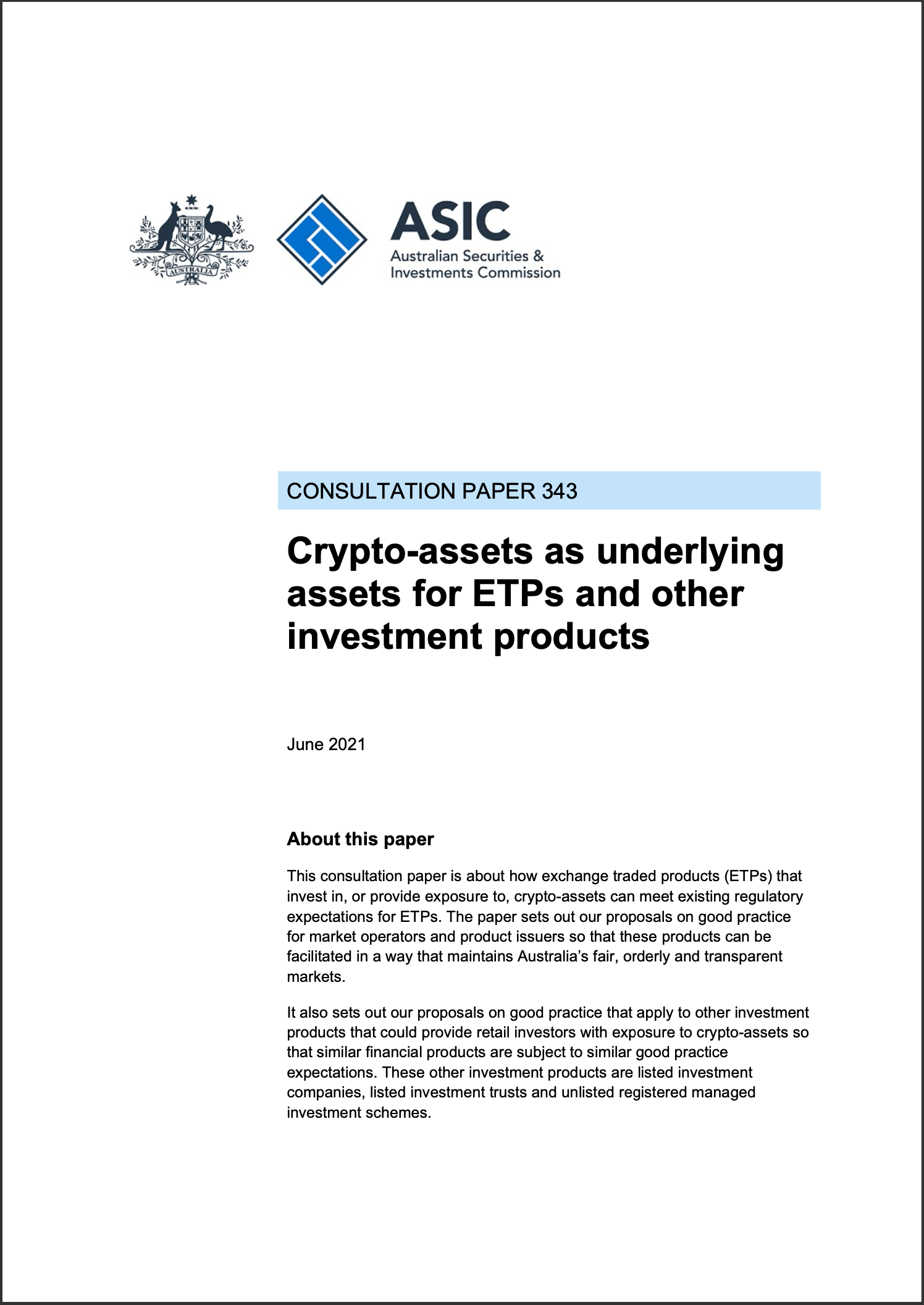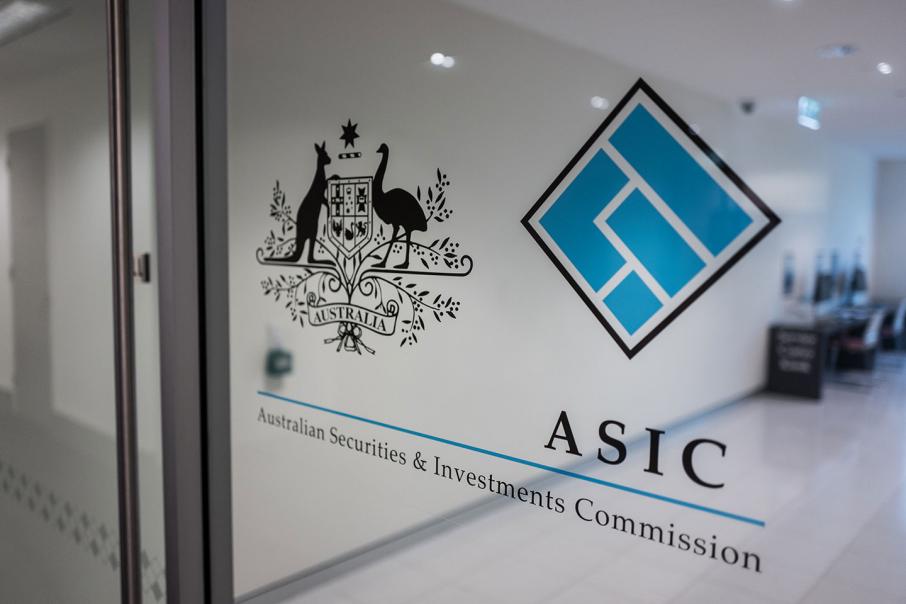Sep 22, 2021
Australia’s ASIC prepares ground for crypto ETFs with CF Benchmarks-like policies
ASIC’s crypto ETF consultation paper reads quite like a CF Benchmarks document

The background from Down Under
- As institutional appetite for regulated digital assets continues to escalate, it’s been an open secret for months that gatekeepers in Australia’s relatively modest listed fund market are preparing the ground for the region to be among the next to launch a crypto ETF
- Even more intriguing however, are indications that Aussie regulators could model rules governing the nascent listed cryptoasset industry directly on CF Benchmarks’ Benchmark Methodology
The year ETFs went crypto
No question that 2021 is the year when cryptocurrencies have broken free of the bounds of the purist crypto industry and begun to join the institutional investment establishment. A list of funds launched during 2021 that have opted to calculate daily net asset value (NAV) with reference to a regulated CF Benchmarks index alone is instructive.
Evolve Bitcoin ETF (EBIT)
Evolve Ether ETF (ETHR)
QR Capital Bitcoin ETF (QBTC11)
QR Capital Ether ETF (QETH11)
Bitcoin Strategy ProFund Mutual Fund (BTCFX)
Victory Hashdex Nasdaq Crypto Index Fund (private)
These new vehicles were preceded by WisdomTree Europe’s longstanding exchange traded funds, WisdomTree Bitcoin ETP (WBTC) and WisdomTree Ether ETP (WETH).
ASIC’s fast delivery
So, it’s not particularly surprising that the Australian Securities & Investments Commission (ASIC) is attempting to get ahead of the curve by proposing guidelines for governance of listed cryptocurrency funds—before any have been listed there.
After all, Australia’s capital markets regulators are simply doing what many forward-thinking market regulators are doing—thinking ahead.
A recently published ASIC consultation paper lays out applicable standards for any potential Bitcoin ETPs that might eventually be listed in Australia, a signal that the country could be among the next major markets to authorize a Bitcoin exchange traded product.

Surprisingly familiar
The surprising aspect of the news is found in details of the consultation document itself. Like all consultation papers, ASIC’s ‘Crypto-assets as underlying assets for ETPs and other investment products’ contains putative policy proposals.
As its introductory statement reads, the publication is “about how exchange traded products (ETPs) that invest in, or provide exposure to, crypto-assets can meet existing regulatory expectations”. It sets out “good practice for market operators and product issuers” as well as “proposals on good practice that apply to other investment products that could provide retail investors with exposure to crypto-assets”. It contains various proposals under a number of key banners.
Some highlights:
- Under a section titled ‘Suitability of crypto-assets and identifying features’, the ASIC proposes to work with ‘market licensees’ to establish certain factors as the basis for identifying “particular crypto-assets that may be appropriate for underlying assets for an ETP”. These factors include:
“The availability of robust and transparent pricing mechanisms for the crypto-asset, both throughout the trading day and to strike a daily net asset valuation (NAV) price.”
- Under ‘Robust and transparent pricing mechanisms’ ASIC proposes that key “good practices” as the “basis of the pricing mechanism” should:
Reflect a “substantial proportion of trading activity in the relevant pair(s), in a representative and unbiased manner”
Be “designed to be resistant to manipulation”
Comply “with recognised index selection principles such as the International Organization of Securities Commission (IOSCO) Principles for financial benchmarks, the EU Benchmarks Regulation, or other internationally recognised index selection principles”
Very European
It’s worth noting that if the ASIC proposals echo CF Benchmarks’ policies, the ASIC proposals will also be reminiscent of the European Union’s Benchmarks Regulation (BMR) regime (see ESMA).
CF Benchmarks is the only UK FCA regulated cryptoasset benchmark administrator. Given EU-UK Benchmark Administration Equivalence, CF Benchmarks is objectively in compliance with BMR.
Still, the emphasis that CF Benchmarks places on crypto market integrity as an imperative is reflected in the precise wording of our policy, methodology and other documents.
Crucially, parts of the ASIC proposals are aligned with this wording – at times almost verbatim.
Alignments occur with various aspects of CF Benchmarks’ benchmark framework, across a number of published CFB documents.
The similarities between ASIC’s proposals and the wording and substance of CF Benchmarks policies and methodologies are striking.
- We can begin with Section 4 of CF Benchmarks’ ‘Benchmark Statement’, titled ‘Methodology’, part of which reads:
“The methodologies referred to comply with the criteria set out in article 12 of the BMR (the EU’s index Benchmarks Regulation regime) and:
(a) are robust and reliable”
- Likewise, within ‘Eligibility Criteria’, the third section of ‘Constituent Exchange Criteria’:
“The venue has policies to ensure fair and transparent market conditions at all times and has processes in place to identify and impede illegal, unfair or manipulative trading practices.”
- From Section 2 – ‘Overview’, of ‘CME CF Cryptocurrency Real Time Indices Methodology Guide’:
“Each reference rate and real time index represent transparent indicators with independent governance and oversight and build on our experience to accelerate the professionalization of cryptocurrency trading.”
So far, these similarities should all be intriguing enough.
But there are also a some ‘direct hits’:
- From Section 2 of ‘Constituent Exchanges’ in ‘CME CF Cryptocurrency Pricing Products Constituent Exchange Criteria’, under ‘Selection of Constituent Exchanges’:
“To assure that the CME CF Cryptocurrency Pricing Products reflect global cryptocurrency trading activity in a representative and unbiased manner, a geographically diverse set of spot trading venues is included within the current framework.”
That pretty much extinguishes the notion that these echoes in Australia might be down to coincidence.

ASIC does its BRR homework
It’s also worth noting that Aussie securities regulators appeared to apprise themselves of the ‘complete explainer’ on our Bitcoin benchmark methodology: ‘An analysis of the suitability of the CME CF BRR for the creation of regulated financial products’.
The ‘Integrity’ section describes, in great detail, components of the CME CF Bitcoin Reference Rate (BRR) that underpin its market integrity. Headings include ‘Manipulation resistance by design’, ‘Manipulation resistance by exclusion of input data’ and others.
Conclusion – On the front foot
All told, Australia’s markets regulator does indeed appear to have studied CF Benchmarks’ rigorous benchmark methodology, guidelines, principles, and practice closely, before formulating its own proposals for crypto ETP regulation.
If we accept that any regulator of a large and developed financial market would seek best-in-class principles for an emerging asset class, it shouldn’t be surprising that ASIC could source those guidelines from the UK’s only regulated cryptocurrency Benchmark Administrator.
For sure, there’s no way of knowing how similarities between ASIC’s proposals and CF Benchmarks’ index methodology came about. Nor indeed whether CFB’s principles for crypto benchmark governance will make it into ASIC’s final crypto ETP regulation.
Still, it’s worth noting that at $102 billion in AuM as of June 2021, Australia’s ETF market ranks as one of the smallest among developed economies. (Compare that to Japan’s, with AuM of about $450bn as of October 2020.)
If a moderately sized fund market like ASIC’s is going for the ‘gold standard’ of cryptoasset regulation, regulators of more dominant markets can be expected to propose similarly exacting principles as they begin to crystalise cryptoassets rules.
Ultimately, it can only benefit the entire institutional cryptoasset industry if guidelines broadly mirror the independently corroborated controls, demonstrable market representation, and proven manipulation resistance of CF Benchmarks’ Benchmark Methodology.
Understand the CME CF Bitcoin Reference Rate (BRR) in less than 5 mins by watching this video.
Find out more about BRR and CF Benchmarks here.
Download the ASIC consultation paper ‘Crypto-assets as underlying assets for ETPs and other investment products’ from here.
The information contained within is for educational and informational purposes ONLY. It is not intended nor should it be considered an invitation or inducement to buy or sell any of the underlying instruments cited including but not limited to cryptoassets, financial instruments or any instruments that reference any index provided by CF Benchmarks Ltd. This communication is not intended to persuade or incite you to buy or sell security or securities noted within. Any commentary provided is the opinion of the author and should not be considered a personalised recommendation. Please contact your financial adviser or professional before making an investment decision.
Note: Some of the underlying instruments cited within this material may be restricted to certain customer categories in certain jurisdictions.
Weekly Index Highlights, December 22, 2025
Crypto's year-end tape remained selective last week, with BTC up 0.9%, while other high-beta majors slipped. The Infrastructure Sub-Category was a major loser in our CF DACS taxonomy, -10.4%, while implied volatility firmed as realized cooled; and our USDT funding rate measure reset above 10%.

CF Benchmarks
Expansion of the CME CF Cryptocurrency Pricing Products Family to include Hedera, Bittensor and Aptos Reference Rates and Real-Time indices
The Administrator announces the addition of Hedera, Bittensor and Aptos Reference Rates and Real-Time indices to the CME CF Cryptocurrency Pricing Products Family.

CF Benchmarks
Cessation of Hedera and Aptos Settlement Prices and Spot Rates within the CF Cryptocurrency Index Family
The Administrator announces the cessation of Hedera and Aptos Settlement Prices and Spot Rates within the CF Cryptocurrency Index Family

CF Benchmarks